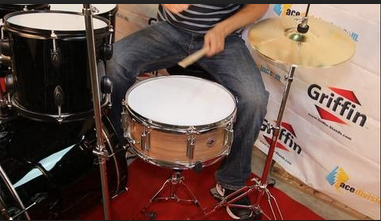SPOILER ALERT!
Picking the Right Snare Drum
As you place your drum kit together, you will surely wish to add a snare drum to your mixture. Also called a side drum, this flexible instrument provides a vast assortment of sounds. From the typical wire-enhanced snare sound, to the time-honored rim shot. Let us take a look at this integral tool and how various factors affect its sound and durability. Our intention is to help you select the ideal snare drum to your style.

Choose the Size to the Sound You Want
The depth of the drum impacts the thickness of the noise. Most are 5 to 6 inches deep, although some go as heavy as 8 inches, with a corresponding depth of noise. Conventional snare drums are 5 inches deep using a 14 inch diameter, and will be the mainstay size for jazz, country, and rock drummers. These are featured on the kits of those playing metal/heavy metal and funk.
Similarly for diameter. A smaller diameter drum will have a higher pitch than a larger diameter mind. Again, it's something you need to hear for yourself to see whether it's a sound you want. The combination of shell diameter and thickness makes its own sonic footprint.
Deep snares are sometimes used as alternatives on rock kits, or on bass and drum setups. Piccolo snare drums are generally only 3 inches deep using a 13 inch diameter, and that retains the sound crisper with a high pitch. Piccolos tend to be prominent on the kits of drummers playing pop, reggae, jazz and hip-hop. A lighter, brighter sound is accomplished, and the piccolo is frequently utilized as another or other snare on the kit.
What It Is Made of Determines What it is Made For
Snare drums produce different sounds depending on the substances they're composed of. Jazz snare drums are typically made of wood or brass, with maple being the overriding material. This also gives the drum a rich, deep sound. Rockers like snare drums made from stainless steel and that different and louder sound helps it be heard against electrical guitar riffs. Metal drummers and punk rockers such as a snare drum that produces a lot of noise at higher pitch. Plus it must handle some fairly heavy actions. Their snare drums generally feature materials like aluminum, bronze, brass, or synthetics such as carbon dioxide or acrylic.
The Difference the Head Makes
The drumhead the drummer strikes will greatly influence the sound. Funk drummers like a tightly tuned head made of durable material that will deliver instant, full-bodied sound. Those favoring punk seem to prefer a tighter setup that produces crisper action and sound. Jazz drummers usually outfit their snares with a textured drumhead that improves the nuanced, muffled noise they desire. And rockers want a slightly muffled sound rippling through a thick drumhead. For them, the right drum head provides the trap more"thump" and less"crack"
More closely tuned heads will establish less lasting, regardless of material. But the difference is not so good you should let it affect your own setup. Tune the mind to your style, and let it rip. Most heads will give you a decent return on your investment.
Conclusion
As you put your place together, or pick a snare drum to get an existing set, consider your needs and style. Then choose the right snare drum that will deliver the sound you're looking for.
For more details kindly visit snare drum.
